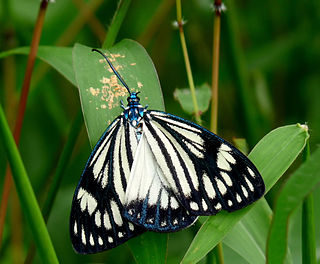| Hestiochora | |
|---|---|
| Scientific classification | |
| Kingdom: | Animalia |
| Phylum: | Arthropoda |
| Class: | Insecta |
| Order: | Lepidoptera |
| Family: | Zygaenidae |
| Subfamily: | Procridinae |
| Genus: | Hestiochora Meyrick, 1886 [1] |
Hestiochora is a genus of moths of the family Zygaenidae.
| Hestiochora | |
|---|---|
| Scientific classification | |
| Kingdom: | Animalia |
| Phylum: | Arthropoda |
| Class: | Insecta |
| Order: | Lepidoptera |
| Family: | Zygaenidae |
| Subfamily: | Procridinae |
| Genus: | Hestiochora Meyrick, 1886 [1] |
Hestiochora is a genus of moths of the family Zygaenidae.

The Zygaenidae moths are a family of Lepidoptera. The majority of zygaenids are tropical, but they are nevertheless quite well represented in temperate regions. Some of the 1000 or so species are commonly known as burnet or forester moths, often qualified by the number of spots, although other families also have 'foresters'. They are also sometimes called smoky moths.

Procridinae is a subfamily of the family Zygaenidae.
Hestiochora continentalis is a moth of the family Zygaenidae. It is found in Australia from southern Queensland through New South Wales to Victoria, South Australia and Western Australia.
Hestiochora furcata is a moth of the family Zygaenidae. It is found in Australia from southern Queensland through New South Wales to Victoria and South Australia.
Hestiochora queenslandensis is a moth of the family Zygaenidae. It is found in Australia from south-eastern Queensland and northern New South Wales.
Hestiochora xanthocoma is a moth of the family Zygaenidae. It is found Australia from the tropical parts of the Northern Territory and Queensland.
Hestiochora occidentalis is a moth of the family Zygaenidae. It is endemic to the temperate parts of Western Australia.
Hestiochora intermixta is a moth of the family Zygaenidae. It is found in Australia from Queensland, New South Wales and South Australia.

Pollanisus viridipulverulenta, the satin-green forester, is a moth of the family Zygaenidae. It is found in the eastern part of Australia.
Pollanisus nielseni is a moth of the family Zygaenidae. It inhabits the Australian state of Western Australia, mostly coastal areas, and has brilliantly shiny forewings. The diurnal adults are most active on sunny days. Eggs are laid on the plant Hibbertia spicata, and females touch each egg after oviposition with a tuft of hair on their abdomen, which attaches protective spines. The larvae are brightly coloured and feed on H. spicata before pupation.
Pollanisus subdolosa is a moth of the family Zygaenidae. It is found in Australia in Victoria and from south-eastern Queensland to New South Wales.
Pollanisus calliceros is a moth of the family Zygaenidae. It is found in Australia in Tasmania, Victoria and New South Wales.

Pollanisus is a genus of moths of the family Zygaenidae. They are native to Australia and many species have metallic forewings and bodies.
Homophylotis is a genus of moths of the family Zygaenidae.
Myrtartona is a genus of moths of the family Zygaenidae.
Myrtartona mariannae is a species of moth in the family Zygaenidae. It is only known from Milmerran in south-eastern Queensland.
Onceropyga is a genus of moths of the family Zygaenidae.
Pseudoamuria is a genus of moths of the family Zygaenidae.
Thyrassia procumbens is a species of moth in the family Zygaenidae. It is found on Java and Sumatra.
| This article on a moth of the family Zygaenidae is a stub. You can help Wikipedia by expanding it. |